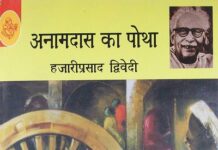I am yet to visit Somnath. During these times, I do not even know when I can visit it. However, this book has been in my library for good 18+ years. I must have bought it when I used to love in Noida as it has the stamp of Tekson’s shop there. I had earlier read ‘Vaishali ki Nagarvadhu’ by Acharya Chatursen, just before I visited the city of Vaishali. Fell in love with his writing, his bringing alive the ancient cities of Pataliputra, Rajgriha, and of course Vaishali.

I had all the intentions of reading all his works, but many other things and books came in between. It took me a long time to read this book, for it demands attention and it also leaves you in a bit of daze. Chatursen Ji takes you back to the Somnath of the time when the last and final attack was made on it by Mehmud Ghazni.
The story starts at the Somnath temple that is being visited by both the Bhimdev – the emperor of Gujarat and Mehmud Ghazni. They are both blessed by the acharya there. You get introduced to the glory of the first Jyotirlinga, the most prosperous temple on the west coast of India. You feel its richness in architecture, its gen studded pillars, its dancers and its Pujari. Then the author introduces the rivalry between Shaiva and Shakta sects that follow Somnath and Tripur Sundari.
Buy Somnath by Acharya Chatursen at Amazon
Then begins the journey of Mehmud Ghazni from Ghazni for the 17th attack on Somnath. He is driven by the wealth he must acquire and the Murtis he must demolish. As he meanders his way through western India, crossing many Rajputana and Gurjara states, you get introduced to the small states and their kings. You learn the dynamics of Indian politics that let a small army of Ghazni not just travel across the desert, but also let him achieve his mission to destroy Somnath. One does admire Mehmud Ghazni for his intelligent use of all possible tricks including the use of Sufi saints as detectives and to convert the local population.
You realize how only weak link in the chain of states, like the one at Ajmer near Pushkar or one secret underground path revealed by one guy who sided with him due to personal rivalry. A literal example of a chain being as strong as its weakest link.
Read More – Aavarana by S. L. Bhyrappa – A Kannada Classic
Relationship of Dev and Devotees
In the beginning, the Gang Sarvagya – the main Pujari of Somnath, talks about the relationship between Dev and Devotees. He talks about ‘if Devta needs to be protected or Devta is supposed to protect us’? Very interestingly he says, the Devta in the Murti is as strong as our Bhakti in it. He hints at the lack of resolve in Indian kings and contrasts it with the missionary zeal of Mahmud Ghazni. This was my favorite part of the book. The powerful message kind of sets the tone for the rest of the story.
Language is not easy, especially if you are not very comfortable with Hindi. I liked the narrative of Vaishali ki Nagarvadhu much better. In this book, the flow is somehow missing. You get lost in too many names and too many battles. It takes a lot of effort to remember who is on which side and who belongs to which kingdom.
Read More – Kabir by Hazari Prasad Dwivedi
Research Experience
At the end of the book, Acharya Chatursen talks about his experience of doing research for this book. The author met the only other author who has written about Somnath – K M Munshi, and the meeting was not great. He collected all possible information about the temples, the attacks of Ghazni, Shaivism practiced at Somnath, and about the political landscape of this time. He gives a brief introduction to his research material that forms good 50 pages at the end of the story. It clearly tells you the fictional characters he created to convey the story of real historical characters.
Remember he was doing all this in the 1940s while the new Somnath temple did not even exist. The success of ‘Vaishali ki Nagarvadhu’ was already behind him. He obviously wanted to write something better than that. Not sure what he thought of his work, but I think Vaishali is a far better work than this one. Not that it is bad, but the grip on the subject is not as strong.
I also read ‘Devangana’ by him, which talks about the decline of Buddhism due to the greed of Buddhist monks and monasteries. It is a small novella that leaves an impression on you.
Read More – Raag Darbari by Shrilal Shukla
Indian Yesteryears
It is an important book from many perspectives and the author has woven multiple layers in his narratives. You see the Indian of yesteryears, you see the pilgrims, festivals, kingdoms, kings, queens, and shrewd ministers. You see the drive of Ghazni, his brush with fate, and his nurturing of his network in the country.
To keep the ‘Rasa’ in the story, there are a couple of intense love stories that travel with the narrative.
Overall, an intense, consuming and educating book. Read it.









Please also take a look at this summary !!